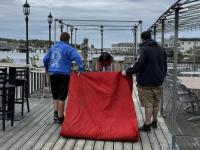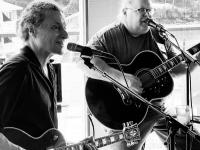Potholes: Winter’s worst impressions
Loose ball joints, rusted brake cables and worn out struts are signs that winter’s waning months have left our roads (and vehicles) in pretty rough shape.
And while we all recognize that spring is in the air, it’s also time to celebrate Maine's frost heave and pothole season.
Almost a quarter of million dollars is spent in Boothbay each year repairing roads, from replacing culverts, digging drainage and patching up holes. And while frost heaves put holes in our roads and our wallets, the Boothbay Public Works Department is constantly figuring out ways to maintain better roads at a lower cost to the town and the taxpayer.
So what causes extensive road damage? Moisture from melting snow and rain seeps beneath the road’s surface. When that moisture freezes, it expands, pushing up the pavement and causing frost heaves. As temperatures warm up again, the top surface of pavement remains elevated above the once frozen area below, which creates a cavity between the bump and the subsurface. Over time the cavity crumbles under the weight of traffic, resulting in a pothole.
Preventing road damage in Boothbay starts with snow removal, so when Town Manager Jim Chaousis took office in 2010, one of the first things he did was hire Mike Alley as the public works foreman. Alley, who has a background in road construction, has it down to a science, Chaousis said.
Some towns use more sand than salt on the roads, which creates more traction, but it doesn’t get rid of the ice and water on the road. That excess moisture is what feeds the frost heaves; so, depending on the conditions, Alley adjusts the salt and sand ratio on the fly depending on the weather conditions.
“I think our public works foreman and I are on the same page,” Chaousis said. “Getting the water or the ice off the road as soon as possible will prevent some of the long term maintenance of road issues.”
In a world of perfect pavement, all roads have a proper sub-surface and drainage, but in Boothbay, the public works crew have seen some pretty strange things.
“When they did Back River recently they were digging up what they thought was an old culvert. Well, there was a culvert there and it was on top of another culvert, which was on top of a split rail,” Chaousis said. “When you think about it, when everything beneath the road is freezing and flexing, it’s pushing all that stuff around.”
Many of Boothbay’s roads were built up from old carriage trails without proper sub-base that absorbs moisture. So the public works crew will typically take up damaged sections of the road that have bad frost heaves and crumbling sunken sections, and fill the holes with aggregate material.
“Mike will go in there, dig it all out and put in some more aggregate and then pave over it, and it seems to be doing OK,” Chaousis said. “We think that in the four years we’ve been doing this that we’re seeing a positive effect.”
Eliminating the problem areas and paving the roads in the same general areas, will hopefully keep the surrounding roads that tie into each other at relatively the same age, Chaousis said.
“If we had unlimited time and resources we could fix anything,” Chaousis said. “But we don’t. We have limited resources, so we have to pick and choose.”
The temporary sneak peak list of roads due to be paved this year include: the back end of Back River Road; Back Narrows Road; and Beath Road. But based on the bumps this spring, we want to know what are the worst roads in Boothbay.
Event Date
Address
United States

























